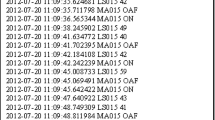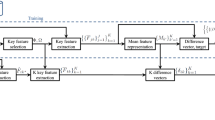Abstract
The delivery of Ambient Assisted Living services, specifically relating to the smart-home paradigm, assumes that people can be provided with help, automatically and in real time, in their homes as and when required. Nevertheless, the deployment of a smart-home can lead to high levels of expense due to configuration requirements of multiple sensing and actuating technology. In addition, the vast amount of data produced leads to increased levels of computational complexity when trying to ascertain the underlying behavior of the inhabitant. This contribution presents a methodology based on feature selection which aims to reduce the number of sensors required whilst still maintaining acceptable levels of activity recognition performance. To do so, a smart-home dataset has been utilized, obtaining a configuration of sensors with the half sensors with respect to the original configuration.
Access this chapter
Tax calculation will be finalised at checkout
Purchases are for personal use only
Preview
Unable to display preview. Download preview PDF.
Similar content being viewed by others
References
Streitz, N., Nixon, P.: The disappearing computer. Communications of the ACM 48(3), 32–35 (2005)
John, G.H., Kohavi, R., Pfleger, K., et al.: Irrelevant features and the subset selection problem. ICML 94, 121–129 (1994)
Koller, D., Sahami, M.: Toward optimal feature selection. Stanford InfoLab (1996)
Dash, M., Liu, H.: Feature selection for classification. Intelligent data analysis 1(3), 131–156 (1997)
Chen, L., Hoey, J., Nugent, C.D., Cook, D.J., Yu, Z.: Sensor-based activity recognition. IEEE Transactions on Systems, Man, and Cybernetics, Part C: Applications and Reviews 42(6), 790–808 (2012)
Wu, X., Kumar, V., Quinlan, J.R., Ghosh, J., Yang, Q., Motoda, H., McLachlan, G.J., Ng, A., Liu, B., Philip, S.Y., et al.: Top 10 algorithms in data mining. Knowledge and Information Systems 14(1), 1–37 (2008)
van Kasteren, T., Krose, B.: Bayesian activity recognition in residence for elders. IET (2007)
Vapnik, V.: The nature of statistical learning theory. Springer Science & Business Media (2000)
Cherkassky, V., Mulier, F.M.: Learning from data: concepts, theory, and methods. John Wiley & Sons (2007)
Van Kasteren, T., Noulas, A., Englebienne, G., Kröse, B.: Accurate activity recognition in a home setting. In: Proceedings of the 10th International Conference on Ubiquitous Computing, pp. 1–9. ACM (2008)
Hall, M., Frank, E., Holmes, G., Pfahringer, B., Reutemann, P., Witten, I.H.: The weka data mining software: an update. ACM SIGKDD explorations newsletter 11(1), 10–18 (2009)
Hall, M., Witten, I., Frank, E.: Data mining: Practical machine learning tools and techniques. Kaufmann, Burlington (2011)
Calzada, A., Liu, J., Wang, H., Kashyap, A.: Dynamic rule activation for extended belief rule bases. In: International Conference on Machine Learning and Cybernetics (ICMLC), vol. 4, pp. 1836–1841. IEEE (2013)
Kohavi, R., Sommerfield, D.: Feature subset selection using the wrapper method: Overfitting and dynamic search space topology. In: KDD, pp. 192–197 (1995)
Calzada, A., Liu, J., Nugent, C., Wang, H., Martinez, L.: Sensor-based activity recognition using extended belief rule-based inference methodology. In: 2014 36th Annual International Conference of the IEEE Engineering in Medicine and Biology Society (EMBC), pp. 2694–2697. IEEE (2014)
Author information
Authors and Affiliations
Corresponding author
Editor information
Editors and Affiliations
Rights and permissions
Copyright information
© 2015 Springer International Publishing Switzerland
About this paper
Cite this paper
Quesada, F.J., Moya, F., Espinilla, M., Martínez, L., Nugent, C.D. (2015). Feature Sub-set Selection for Activity Recognition. In: Geissbühler, A., Demongeot, J., Mokhtari, M., Abdulrazak, B., Aloulou, H. (eds) Inclusive Smart Cities and e-Health. ICOST 2015. Lecture Notes in Computer Science(), vol 9102. Springer, Cham. https://doi.org/10.1007/978-3-319-19312-0_27
Download citation
DOI: https://doi.org/10.1007/978-3-319-19312-0_27
Published:
Publisher Name: Springer, Cham
Print ISBN: 978-3-319-19311-3
Online ISBN: 978-3-319-19312-0
eBook Packages: Computer ScienceComputer Science (R0)




